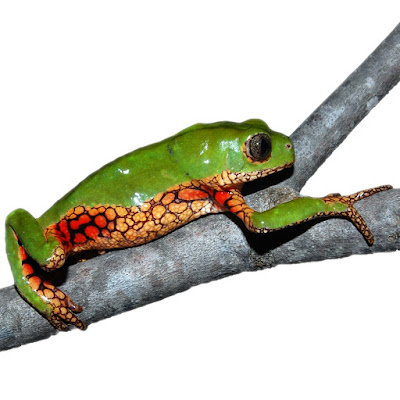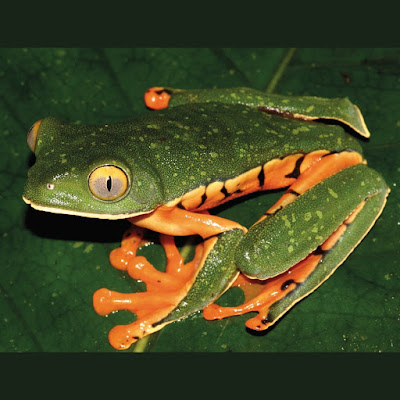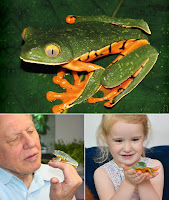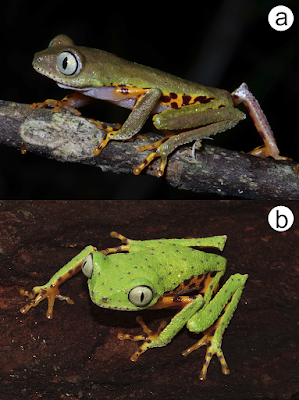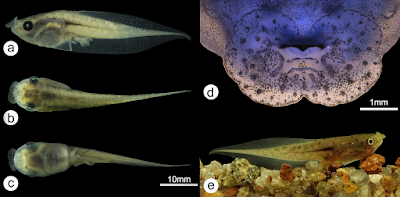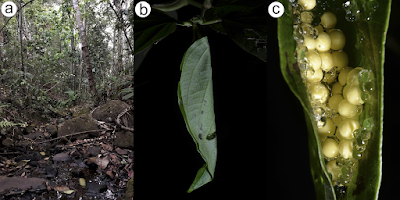Pithecopus araguaius Haga, de Andrade, Bruschi, Recco-Pimentel & Giaretta, 2017 |
Abstract
The Neotropical frog genus Pithecopus comprises currently 10 species. A recent molecular phylogeny suggested the existence of two subclades within it, one of them including P. palliatus, P. azureus, P. hypochondrialis, and P. nordestinus (lowland species). Herein we describe a new species of this subclade from Pontal do Araguaia, in the Brazilian Cerrado in the Mato Grosso state. Recognition of the new species is supported by adult morphology, advertisement call and molecular data. The new species differs from Pithecopus highland species by its smaller head width and lack of the reticulate pattern on flanks. From lowland species, the new form differs by being significantly smaller in snout vent-length, advertisement call with the greatest number of pulses, and high genetic distance. Interestingly, we also report on occurrence of P. hypochondrialis (its sister species) at an adjacent site (about 3km). Also, we report on the occurrence of the new species in the Chapada dos Guimarães and Santa Terezinha, both also in the Mato Grosso state.
Pithecopus araguaius sp. n.
Type locality: Pontal do Araguaia (418 m above sea level), Mato Grosso state, Brazil.
Diagnosis: Pithecopus araguaius sp. n. is assigned to the genus Pithecopus (former Phyllomedusa hypochondrialis species group) by the following set of characters: (1) small body size; (2) dorsolateral macroglands (sensu) indistinct; (3) smooth skin on back and granulose on belly; 4) fingers and toes long and slender with terminal discs poorly developed; (5) grasping (opposable to the others) finger I and toe I. The new species differs from the highland Pithecopus species by its (6) smaller head width; and (7) lack of the reticulate pattern on flanks; and from the lowland species by having significant differences in its (8) smaller snout vent-length, and (9) call with a greater number of pulses.
Etymology: The epithet araguaius it is masculine latinized form of the indigenous Tupi word “araguaia”, a reference to the Araguaia River, which cross the type-locality of the new species.
Distribution: Based on the morphological and genetic similarities between populations from Pontal do Araguaia, Chapada dos Guimarães and Santa Terezinha (all MT), the specific identity between all three is well supported. Chapada dos Guimarães and Santa Terezinha are about 380 km west and 630 km north from the type-locality of P. araguaius sp. n., respectively. Based on the distribution provided by Bruschi et al. [2013], the range of the new species overlaps with that of P. hypochondrialis South, but not with those of P. azureus and P. nordestinus (see their Fig 2).
....
Isabelle Aquemi Haga, Felipe Silva de Andrade, Daniel Pacheco Bruschi, Shirlei Maria Recco-Pimentel and Ariovaldo Antonio Giaretta. 2017. Unrevealing the Leaf Frogs Cerrado Diversity: A New Species of Pithecopus (Anura, Arboranae, Phyllomedusidae) from the Mato Grosso state, Brazil. PLoS ONE. 12(9): e0184631. DOI: 10.1371/journal.pone.0184631
---------------------------------------------------------------
روابط التحميل والمشاهدة، الروابط المباشرة للتحميل
او
شاهد هذا الفيديو القصير لطريقة التحميل البسيطة
كيف تحصل على مدونة جاهزة بآلاف المواضيع والمشاركات من هنا
شاهد قناة منتدى مدونات بلوجر جاهزة بألاف المواضيع والمشاركات على اليوتيوب لمزيد من الشرح من هنا
رابط مدونة منتدى مدونات بلوجر جاهزة بآلاف المواضيع والمشاركات في أي وقت حــــتى لو تم حذفها من هنا
شاهد صفحة منتدى مدونات بلوجر جاهزة بألاف المواضيع والمشاركات على الفيس بوك لمزيد من الشرح من هنا
شاهد صفحة منتدى مدونات بلوجر جاهزة بألاف المواضيع والمشاركات على الفيس بوك لمزيد من الشرح من هنا
تعرف على ترتيب مواضيع منتدى مدونات بلوجر جاهزة بآلاف المواضيع والمشاركات (حتى لا تختلط عليك الامور) من هنا
ملاحظة هامة: كل عمليات تنزيل، رفع، وتعديل المواضيع الجاهزة تتم بطريقة آلية، ونعتذر عن اي موضوع مخالف او مخل بالحياء مرفوع بالمدونات الجاهزة بآلاف المواضيع والمشاركات، ولكم ان تقوموا بحذف هذه المواضيع والمشاركات والطريقة بسيطة وسهلة. ــــــــــــــــــــــــــــــــــــــــــــــــــــــــــــــــــــــــــــــسلامـ.




